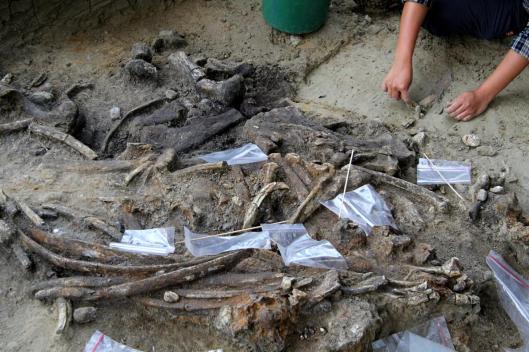- Beranda
- Berita Luar Negeri
Someone Butchered a Rhino in the Philippines 700,000 Years Ago, But Who?
...
TS
hahaiyaa.20
Someone Butchered a Rhino in the Philippines 700,000 Years Ago, But Who?
Someone Butchered a Rhino in the Philippines 700,000 Years Ago, But Who?
Yesterday, Nature published an alarming find of butchered rhinoceros remains from the Kalinga site in the Cagayan Valley on Luzon in the Philippines. The long bones were clearly smashed as if to have access to marrow. The cut marks over the ribs are also clear signs of processing the meat off the bones. These marks were not accidental.
What makes this so alarming is the bones are dated between 631,000 and 777,000 years old. The best accurate date is 709,000 years ago. 57 associated stone tools were also found from this site.

Researchers found a 700,000-year-old site on the Philippine island of Luzon where unknown hominins butchered a rhinoceros. To avoid damaging the bones, the team dug them up with only bamboo sticks.
Since the ’50’s, Kalinga has yielded animal remains and stone tools but the context wasn’t known until now. The other earlier archaeological evidence couldn’t be dated. So, the only other dated evidence of Philippine hominid occupation in Luzon is 67,000 years ago.
You know that in ’04 we found about H. floresiensis on Flores. In ’16 we found about 118,000 stone tools on Sulawesi. But we have around 600,000 years unaccounted for. It begs us to ask the question, just which species of humans were hunting rhino on what we know as the Philippines over 700,000 years ago?

Different types of marks at the surface of the bones.
Possible candidates are Denisovans and Homo erectus. We only know of Denisovans by traces in DNA and a Siberian fossils. Personally, if I were a betting man, I’d place wagers on H. erectus, since it definitely made its way into southeast Asia and into Java around 700,000 years ago.
Lead study author Thomas Ingicco, an archaeologist with France’s National Museum of Natural History, thinks the butchers may have been Luzon’s version of H. floresiensis, which may have descended from a population of H. erectus that ended up on Flores.
haiyaaa ciilaaka luuwa weelas waaa
Kadang2 ane pikir salah pilih kerjaan,kek nyeee jd arkeolog ato antropolog lebih menggelitik waaa!!!
Yesterday, Nature published an alarming find of butchered rhinoceros remains from the Kalinga site in the Cagayan Valley on Luzon in the Philippines. The long bones were clearly smashed as if to have access to marrow. The cut marks over the ribs are also clear signs of processing the meat off the bones. These marks were not accidental.
What makes this so alarming is the bones are dated between 631,000 and 777,000 years old. The best accurate date is 709,000 years ago. 57 associated stone tools were also found from this site.

Researchers found a 700,000-year-old site on the Philippine island of Luzon where unknown hominins butchered a rhinoceros. To avoid damaging the bones, the team dug them up with only bamboo sticks.
Since the ’50’s, Kalinga has yielded animal remains and stone tools but the context wasn’t known until now. The other earlier archaeological evidence couldn’t be dated. So, the only other dated evidence of Philippine hominid occupation in Luzon is 67,000 years ago.
You know that in ’04 we found about H. floresiensis on Flores. In ’16 we found about 118,000 stone tools on Sulawesi. But we have around 600,000 years unaccounted for. It begs us to ask the question, just which species of humans were hunting rhino on what we know as the Philippines over 700,000 years ago?

Different types of marks at the surface of the bones.
Possible candidates are Denisovans and Homo erectus. We only know of Denisovans by traces in DNA and a Siberian fossils. Personally, if I were a betting man, I’d place wagers on H. erectus, since it definitely made its way into southeast Asia and into Java around 700,000 years ago.
Lead study author Thomas Ingicco, an archaeologist with France’s National Museum of Natural History, thinks the butchers may have been Luzon’s version of H. floresiensis, which may have descended from a population of H. erectus that ended up on Flores.
haiyaaa ciilaaka luuwa weelas waaa
Kadang2 ane pikir salah pilih kerjaan,kek nyeee jd arkeolog ato antropolog lebih menggelitik waaa!!!

anasabila dan sebelahblog memberi reputasi
2
991
6
Tulis komentar menarik atau mention replykgpt untuk ngobrol seru
Mari bergabung, dapatkan informasi dan teman baru!
Berita Luar Negeri
79.3KThread•11.2KAnggota
Urutkan
Terlama
Tulis komentar menarik atau mention replykgpt untuk ngobrol seru